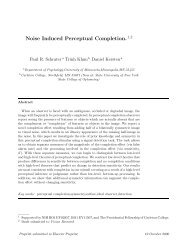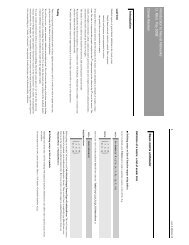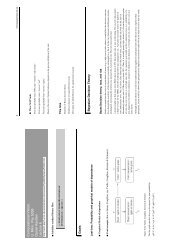Lecture 1: Introduction to Biological Vision - Vision Research ...
Lecture 1: Introduction to Biological Vision - Vision Research ...
Lecture 1: Introduction to Biological Vision - Vision Research ...
You also want an ePaper? Increase the reach of your titles
YUMPU automatically turns print PDFs into web optimized ePapers that Google loves.
Retinal mosaic & regularsamplingFrom Roorda & Williams, 1999. Figure 3 Pseudocolour image of the trichromaticcone mosaic. Blue, green and red colours represent the S, M and L cones,respectively. a, b, Subject JW's temporal and nasal retina, respectively, at onedegree of eccentricity. c, Subject AN's nasal retina, at one degree of eccentricity.We performed a statistical test for randomness according <strong>to</strong> Diggle27. Wecompared the distribution of all intercone distances of the measured M-conearray with 100 simulations derived from the same mosaic in which the samenumber of M cones were randomly assigned. JW's array was no different fromrandom at either location. AN's array showed significant clumping of the data(€ , 0X01) but, because of optical blur, the possibility of a random assignmen<strong>to</strong>f M cones cannot be ruled out. Scale bar represents 5 arcmin of visual angle.Wednesday, August 29, 12










